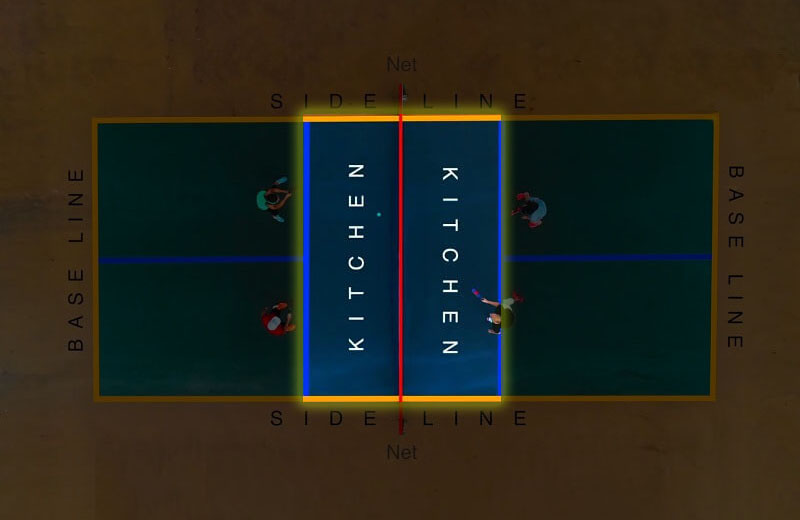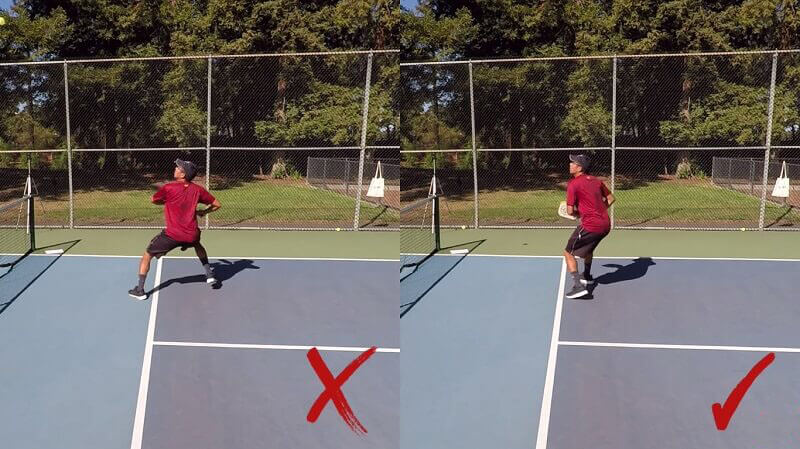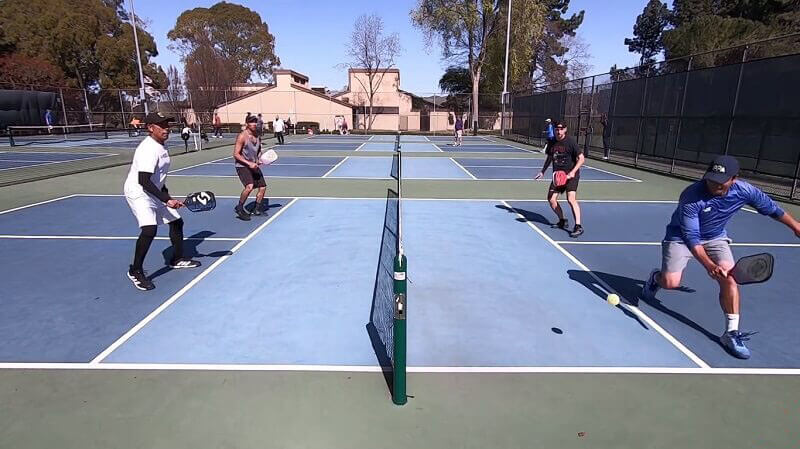What Is the Kitchen in Pickleball?
In Pickleball rules, the non-volley zone often referred to as the kitchen in pickleball, is delineated by a line that runs parallel to the net, 7 feet out from the net on either side of the net.
The idea behind the kitchen is to reduce the “smash” hits that are common in racquetball, squash, tennis, badminton, and other sports. A close-range smash hit at the net always ends the play and disadvantages the opponent due to the forceful, quick impact.
One important aspect of the pickleball kitchen rule is that it only applies to the actual ground, not the area above it. You are permitted to use your pickleball paddle to volley over the kitchen while standing outside the kitchen (but not on the kitchen line) per the rule.
5 Pickleball Kitchen Facts
- The pickleball non-volley zone rule is an integral part of pickleball play, and understanding the rules in the kitchen area can help you better your game. The pickleball kitchen refers to the non-volley zone (NVZ), located 7 feet from each side of the pickleball net. This 7-foot non-volley zone extends across the width of the court, so players need to be aware of where this line is when playing pickleball in a kitchen setting.
- Players are not allowed to volley within this area; if they do, they will lose a point, and their opponent will receive a point instead. If a player steps into or over the pickleball kitchen line while volleying, they will lose a point.
- It is important to note that pickleball players are allowed to volley within the Non-volley zone as long as they do not step on the line or go over it; this means that pickleball players can move around within the pickleball kitchen area without losing points.
- The pickleball non-volley zone rule applies to all pickleball play, regardless of whether you’re playing singles or doubles. This rule helps to keep pickleball from fouling and keeps the game flowing smoothly by ensuring that only legally hit shots are made.
- The pickleball non-volley zone rule also serves an essential purpose by helping new players learn how to properly execute volleys, which is an important skill to master in pickleball.
Read more: “Pickleball Line Rules Explained: Is It In Or Out?”
All Pickleball Kitchen Rules Explained
The kitchen rules come under section number 9 of the USAPA Rulebook of 2023. Below we have explained the kitchen rules for a normal game and a wheelchair pickleball game from 9A to 9H.
Kitchen Rule Number 9A
The first kitchen rule states that when playing a volley stroke, you must be outside the kitchen zone. This means that playing the volley shot in the non-volley zone is prohibited in pickleball.
If the player wishes to play the volley stroke in the wheelchair game, the wheelchair must be in the volley zone. However, the front wheels may come into contact with the non-volley zone.
However, if you play a volley stroke while all wheels are in the Non-volley zone, it will be considered a fault and you will lose a point or serve.
Rule Number 9B
The 9B rule is connected to the first one. According to this rule, it will be a fault if any object or body part of the player touches the Non-volley zone while volleying.
This means that even a slight contact of the foot with the Non-volley zone will cause a fault. However, the wheelchair players have an exception as the front wheels of the chair can touch the kitchen while making a volley stroke.
This rule is subdivided into rules number 9.B.1 and 9.B.2. Here’s the explanation of these divided rules;
- Volleying includes the swing of a paddle, follow through, and increase in momentum.
- If the swinging of pickleball paddles makes contact with the kitchen while volleying, then it would be a fault.
These divided rules further explain rule number 9B. The arms and paddle are considered a part of your body. Therefore if you make a swing and the paddle is inside the Non-volley zone, you’ll have a fault.
Confusing? This might help “What Is A Fault In Pickleball? Common Pickleball Faults Clarified”
Rule Number 9C
Even if you make contact with any object that is inside the Non-volley zone and make a volley stroke, you will be facing a fault. Even if your partner is in the kitchen zone and you touch them due to momentum, you’ll face the problem.
Rule Number 9D
If the player is in the kitchen and then hits the volley shots while their feet or paddle is in the air, it will be a fault. This means that you have to completely move your feet and paddle in the non-volley zone before striking the ball.
In a wheelchair game, the player can only hit the volley stroke once the rear wheels have made contact with the service areas.
Rule Number 9E
This is a pretty simple rule as it states that you can enter the kitchen anytime during the game. However, you can not enter this area to play a volley stroke.
Rule Number 9F
Before or after returning the ball, a player can enter the Non-volley zone. This rule is also self-explanatory as players can enter the zone to play the groundstrokes.
Rule Number 9G
This rule states that you can play a groundstroke in the Non-volley zone. This means that you can play the shot once the ball has bounced on the ground.
Rule Number 9H
If your partner is standing in the kitchen and you are outside this area, you are still eligible to play the volley stroke. Many players get confused about whether both players have to stay out of the kitchen or not.
Therefore USAPA created this rule to clear the confusion. Now the player who returns the ball has to follow the non-volley zone rule.
What Can You Do in The Non-Volley Zone?
Players frequently run into the kitchen to return a short dink. As long as the ball has already been bound, this is acceptable. However, you need to exercise caution since if you’re in the kitchen, you’re also a sitting duck.
The rationale is that whatever volley you make while in the kitchen is instantly an error. However, you will need to let the ball go or wait for it to bounce to avoid volleying it. In other words, your condition is hopeless. Get out as soon as you can if you enter the kitchen!
You’ll feel like the kitchen is some sort of pit of never-ending lava as you play pickleball more frequently. If you must enter the kitchen, don’t be terrified of it! You can groundstroke as much as you want in the kitchen. Simply watch for them to bounce, maintain their composure, advance, and make a thoughtful and balanced stroke
What Can You NOT Do in The Non-volley Zone?
The kitchen zone pickleball is an area within the court located 7 feet from the net. It’s a place that is used by pickleball players to hit shots back and forth or between them as they compete.
It also serves as a safety area from which pickleball players can avoid having their shots returned by opponents standing closer to the net.
Although there are some protocols that picklers must follow when playing in the pickleball kitchen, here are some things you definitely cannot do:
- It is not a good option to move into or beyond the pickleball kitchen during your opponent’s serve. Once you enter it, you must stay in it until your opponent has served and taken their position at the net before you can move away from it.
- You cannot hit the pickleball on your server from within the pickleball kitchen. You must stand outside of it to make a legal service.
- It is not permissible to step into the pickleball kitchen for blocking your opponent’s shots if they are playing at the net. This is considered interference and will result in a point loss for you or your team.
Read more: “Pickleball Serve Rules: A Guide to Pickleball Serving Regulations”
For pickleball players who want to learn more about the non-volley zone rules, it’s important to consult with an experienced pickleball instructor before playing or participating in tournaments.
Knowing the rules is essential for fair play and ensuring that everyone has fun during their pickleball match!
Where Should I Stand? Close to the Non-volley Zone line?
The standing position of a player can help them to avoid breaking the rules. Therefore, you must be acknowledged for the best-standing positions.
You must stand behind the baseline while serving the ball. If the other player is serving, you can stand in the middle of the baseline. This will assist you in navigating and striking the ball accurately. After the serve, you might want to be as close to the kitchen line as possible.
Throughout the game, try to avoid the zone pickleball kitchen because it can be difficult to avoid rule violations in this area.
FAQs
Why Do These Rules Exist?
Is Entering The Kitchen Area a Fault?
Does The Space Above The Kitchen Area Count?
Can you ever go to the Kitchen in Pickleball?
Conclusion
Understanding what the kitchen is and what rules apply to it is essential for every pickleball player. To help you deal with that, we have narrowed down everything you need to know about the kitchen rules above.
Therefore, next time you’re playing pickleball make sure to keep all the above-mentioned rules in mind and ace your game!
Related Article:
- Good Sportsmanship: A Guide to Pickleball Etiquette




